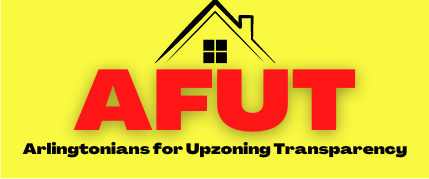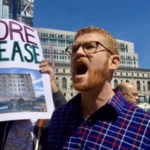Statement of Arlingtonians for Upzoning Transparency
March 6, 2023 Planning Commission Public Hearing
AS PREPARED
I am David Gerk, an Arlingtonian since 2002. I am an attorney, an engineer, and have two girls – ages 5 and 2. I am speaking on behalf of Arlingtonians for Upzoning Transparency (AFUT).
I would like to begin by addressing misstatements by some of the earlier speakers. While we all strongly disapprove of certain past practices in the United States – these proposed amendments have nothing to do with race or affordability or the past.
Single family zoning in Arlington is not preventing teachers or firefighters or people of color from owning homes in Arlington – it’s the cost. And EHO (Expanded Housing Options) will not help. The cheapest EHO unit in a “six-unit building” (according to the County’s own numbers) will require an annual income of at least $174,000 – excluding the moderate income folks testifying tonight who think EHO will open new housing opportunities for them.
Before this Commission today is a proposal for the most drastic change to the zoning framework in at least 50 years; A proposal to rewrite the GLUP in a way that turns on its head Arlington’s award-winning approach of density growth around metro and transit, while retaining single family neighborhood zoning for families and others.
Has Arlington really become so reckless in its approach to governance?
The County has conducted no analysis or studies of impacts. How can you carry out your duties as Commissioners to advise the County Board on “orderly development of the County” without any of this critical information?
Jumping into the void have been local experts – economists and real estate, urban planning, mortgage banking and other professionals in the community. Their conclusion? “Stop.” Do the work that needs to be done to determine the true community impacts.
Arlington continues to approve density and upzoning first—delaying all meaningful planning until after the fact. The MM/EHO upzoning options are no exception.
The refusal to plan in advance—before approving significant land-use changes has brought us:
· A precipitous decline in tree canopy (dropping from 41% in 2016 down to 33% in 2021);
· Heat-trapping, water-shedding impervious surface growth of 2% in just 5 years;
· An antiquated water distribution and sanitary sewer system (springing frequent leaks and barely meeting today’s needs);
· An electric grid that is on life support (prone to outages and fires);
· An antiquated stormwater management system unable to cope with growing storm runoff fueled by increasing imperviousness and loss of tree canopy;
· Schools with a permanent supply of “trailer classrooms,” without which most would be overenrolled;
· A small supply of oversubscribed public land (leading to conflicts over its use) with no plans or funding to add significantly to that supply;
· Decreasing levels of service at major (and some minor) intersections, leading to increasing gridlock and pollution; and
· An emergency response system already stressed and understaffed, with particularly long response times north of Langston Blvd.
Turns out that pasting a dense, 21st century population on top of infrastructure designed for the 1940s and 1950s (or earlier) doesn’t work out so well.
So, I’m asking the Planning Commission to live up to its name. Withhold the decision to recommend any option(s), and defer any decision on the proposed amendments to the GLUP and Zoning Ordinance. Ask the County Board to do the same until county staff provide comprehensive impact analyses on the cumulative impacts at full build-out for each proposed option.
This is vital because builders and developers will contribute no additional infrastructure or community benefits beyond what is required by permit for the site itself.
Comprehensive assessments and planning should, at a minimum, include an assessment of the cumulative impacts at full build-out on:
1) Dislocation/displacement of existing low-, middle and fixed-income residents, with a special focus on minority, older adult and disabled residents
2) Water distribution and sanitary sewer systems
3) Stormwater management system and flood risk
4) Existing tree canopy
5) Existing electrical grid
6) Neighborhood streets and minor arterials
7) First-due coverage area on fire/EMS response times
8) Public schools
We all are relying on you to live up to your name as the PLANNING Commission.
# # #
Media Contact: afut.upzoningtransparency@gmail.com

